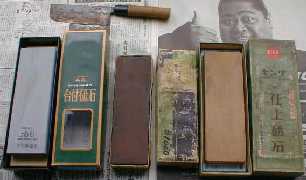| How To Sharpen Knives Like A Professional #2 | Kitchen knife, machete... watanabeblade.com ŠThe other knives |
|
| Special | Standard | Professional |
| Project for Sharpening:@Chip or Not? | ||
| Let's begin to sharpen. But have a look at the edge again. Does your knife
have a chip? I'm going to explain how to sharpen using water stones. If
your knife has a chip longer than 2mm, you should sharpen using a belt
sander, a grinding machine or you should have a cutlery shop do it for
you. Japanese kitchen knives are sharpened using various grades of sharpening stone. These stones have numbers that relate to the roughness of their grain. Rough grain stones (about #600) are called Arato. Medium grain stones (about #1000) are called Nakato. Superfine grain stones (about #6000) are called Shiageto. These names are written on the box and on the side of the stone. Generally, the lower the number, the better the stone is for shaping and roughly sharpening. You should choose your waterstone based on the condition of the edge. If you sharpen your knives everyday (like a sushi chef), you can maintain the sharpness by using only a superfine grain stone. On the other hand, if there is a chip, or if you only sharpen once in several months, you should begin sharpening using a rough grain.  Do you need a razor sharp blade or a strong blade? Next let's look at angle of the edge. When your knife was new, or after sharpening the last time, did your knife cut as you wanted it to? The narrower the angle of the edge, the more your knife will cut like a razor. But the blade will chip easily, because it's thin. On the other hand, if the edge has an obtuse angle, the knife will dull but will be very strong and you will be able to chop fish or meat with bones. If you are beginner, you should not try to change the angle of your edge. You should try to reshape the knife to its original appearance.
By the way, my customer often asked me, "When to resharpen?" Of cause, you can decide that. But I suggest the below. There are several ways to tell when you need to resharpen a knife. One is when you notice a difference in use. If the vegetable seems to be getting harder, check the knife. Finest edge cuts well even a overripe tomato. Another is to look at the edge under a good light. A sharp edge reflects no light. But the most usual indicator is when you see scratches on your cutting food. You know immediately that you have a damaged edge. |
||
| How To Sharpening Site Map #0 Introduction: No More Throw Away Knives! #1 Looking Sharp: Sharp Or Not? #2 Project For Sharpening: Chip Or Not? #3 Blade Of Mechanism: How Is It Cut? #4 Ready For Sharpening: How's Your Water Stone? |
|
| Previous Page | Next page |
| To English top page |
Payment, Shipping... |
Biograph |
Contact Us |
Copyright (C) Watanabe Blade. All Rights Reserved.